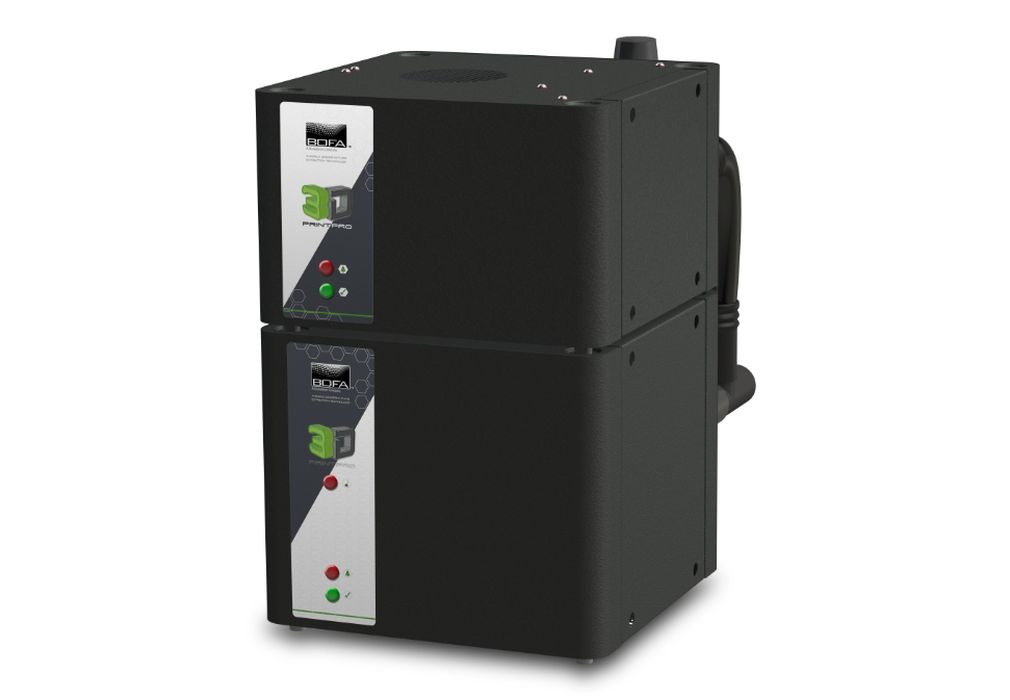
BOFA announced a new device specifically designed for high temperature 3D printing.
Is it a 3D printer? Nope, it’s a fume extractor.
Fume extractors are specialized filtration devices that can be used in any enclosed setting to capture toxic or dangerous fumes. Typically they are used with manufacturing equipment that emits fumes, such as laser cutters, but also includes 3D printers, both filament and resin.
The best way to purge noxious material from the air is to exhaust it outside using a ventilation system. However, there are countless situations where that is not practical. For example, you might not be able to persuade the building manager to allow you to cut a hole in the wall.
In those circumstances, a fume extractor is the solution. It’s a device that can attach to a 3D printer and it soaks up particles and VOCs while the print job proceeds. They are relatively easy to install, as they can be placed anywhere inside a building.
BOFA has made fume extractors for many years, and has recently specialized in producing equipment intended for use with 3D printers. This has been a revelation for many who otherwise had to use alternative safety solutions.
Now BOFA International announced a new device, the PrintPro HT, a fume extractor specifically designed for use with high temperature 3D printers.
Let’s do a quick review of high temperature 3D printing. This is the printing of specific engineering materials at temperatures well beyond the usual 260-300C, such as ULTEM or PEEK. These powerful materials are useful because their softening temperature is so high. It means those parts can be used in many applications where temperatures are higher.
It is quite challenging to 3D print them, however, as the extreme softening temperature implies not only a high hot end temperature, but also a very hot build plate and often a fully heated build chamber. Otherwise the thermal gradient between freshly extruded material and cooling material would be so great that significant warping would occur.
The result is a build chamber that is filled with air that is very hot. At a minimum, heated chambers operate at 70C, but there are others that can be as high as 120C or more.
If you are blowing air out at that temperature and require filtration, that could be a problem for standard fume extractors. They have been designed assuming relatively cool input air, not air that’s at 120C. Those temperatures could damage the fume extractor or even lower the effectivity of the filtration process.
BOFA International realized this and developed the PrintPro HT. It’s designed to handle air and particulate matter emitted by a 3D printer at temperatures up to a sizzling 100C, or as they say:
“The new BOFA system has been designed to filter the high temperature particulate and gases emitted by advanced 3D print units that process polymers at up to 932F (500C). This 3D method is used to create high quality finished products and components for a range of industries. Until now the high temperatures have created challenges for filtration systems that remove the extremely hot airborne fume, gases and nanoparticles emitted by the process.
The newly developed 3D PrintPRO HT uses advanced electronics components and thermal insulation to deliver high levels of filtration performance in chamber environments up to 212F (100C) – a 50% increase over other models in BOFA’s 3D PrintPRO range. This enables the safe removal of both potentially harmful airborne contaminants and particulate that could damage expensive equipment, using an anticipated maximum air flow rate of 75 cu ft/min.”
This should cover almost all of the high temperature 3D printers on the market today, as their air will cool somewhat as it travels to the PrintPro HT.
This is an exciting development for high temperature 3D printing. In recent years interest in “HT” printing has significantly increased, and there are now many high temperature 3D printers and materials on the market.
But there are certainly many who are unable to use them because they don’t have the proper ventilation. Now they have an option to proceed.
Expect high temperature 3D printer sales to increase.
